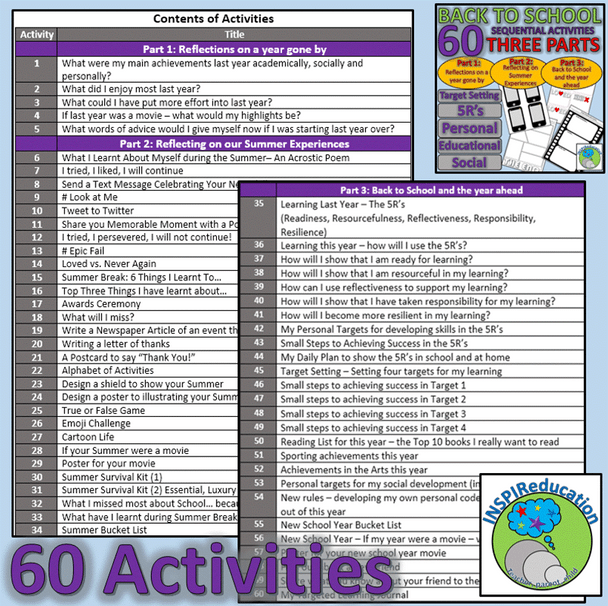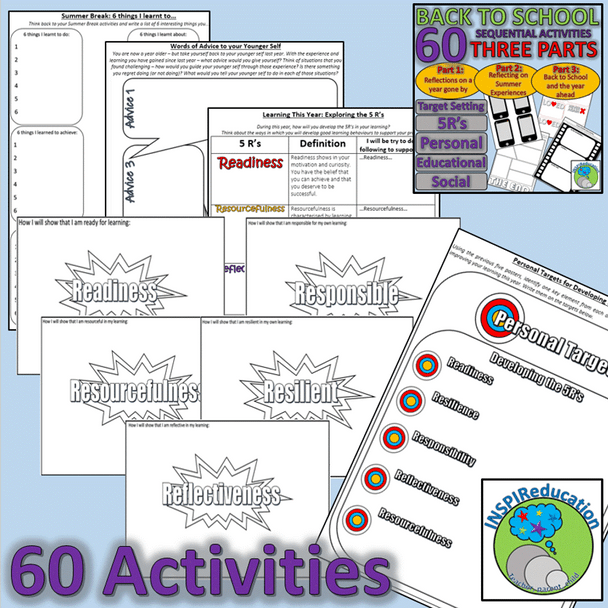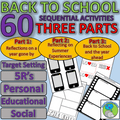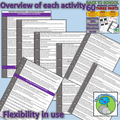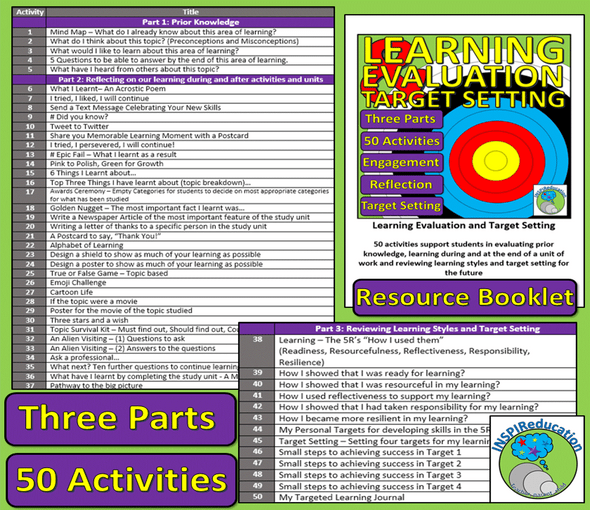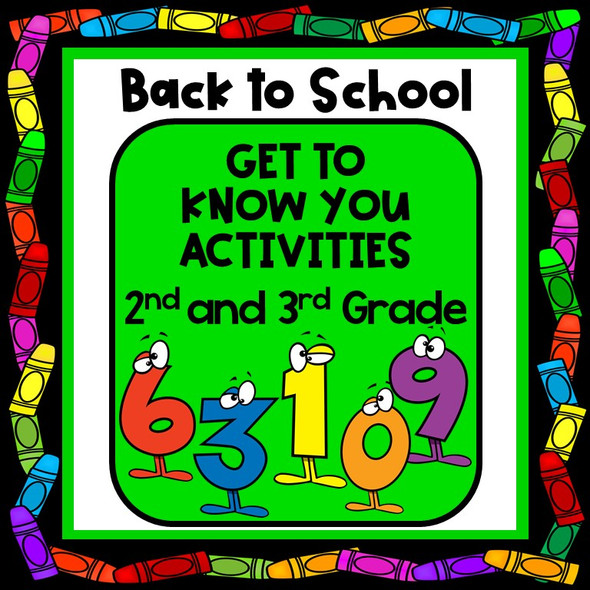Description
We have designed this booklet to support students returning to school and assisting teachers in starting to focus on the targets which students will need to set for themselves in order to move forward in their learning skills, academic targets, sporting, social and arts skills too.
This resource pack contains 60 different activities which have been divided into three separate parts:
1. Reflections on a year gone by (5 activities)
2. Reflecting on our Summer Experiences (29 activities)
3. Back to School, Target Setting and the Year Ahead (26 activities)
Part 1 encourages the children to reflect on the year before, their successes, their areas for improvement, their celebrations and their highlights of the year – as well as offering advice to their younger self on the issues and events that they were to be challenged by.
Part 2 explores the children’s experiences of their Summer Break – focusing on their personal, social, health and emotional development of the children. The activities encourage the children to talk about their experiences and how those experience have impacted on them as people and learners over that time. The activities are structured to ensure that these are within meaningful and structured contexts.
Part 3 looks ahead to the new school year and encourages the students to think about the things they want to achieve, and the actions they can take to support that achievement. It offers opportunities to think about their skills as learners and how they can improve those skills. They are encouraged to set targets for their learning, then take each target and set small, achievable steps for each of the targets with dates alongside each – so creating a learning development journal.
By the end of Part 3, children will have reflected upon the previous learning, and how they learn, and set targets for developing skills in the 5R’s (responsibility, resilience, resourcefulness, readiness and reflectiveness), Social development, curriculum targets, naming 10 books to read in the year they would like to read, targets in the Arts, Sports and Academic areas. Each of the targets will also encourage the students to think about “Small Steps to Achieving Success” – so taking a target they would like to achieve and breaking that target down into smaller, more manageable chunks. In doing so, students see the targets as achievable, and with regular reviews, can see their progress towards achieving the bigger targets.
With so much reflection on how students learn and in setting targets, the 60th activity is to design a cover for a “Target Book”. This will allow the students to keep their targets together in one place and monitor their progress towards achievement.
Not all activities need to be completed. They have been produced to make the start of the year easy for both teachers and students alike. They focus everyone on the needs of the learners – and provide a clear way of developing targets at the start of the year within a wide range of areas in fun, yet meaningful contexts.
Each of these activities should be introduced by the teacher and discussed in full with the group of children including discussing the needs of the activity, ideas of how they could be completed, group discussion of ideas and the resources which can be used to support some of the activities. This allows the activities to be matched to a wide range of year groups as teachers can match the activity to the needs, levels, maturity and understanding of the children within their group. Most year groups can achieve these activities with teacher support and reviewing the expectations to allow success.
Some activities do require modelled support as they are more intensive and draw upon prior learning within writing and research skills to ensure that quality outcomes are achieved. For example, in:
- Postcard writing
- Letter writing
- Newspaper reports
- Non-chronological report writing
- Comic strip design
- SMART target setting
Other activities can be completed with a shorter introduction, explaining the activity, brief demonstration, and then independent completion.
Each activity has an individual resource sheet, this does not mean that each resource sheet should be copied for the children, many can be shown on the Interactive Whiteboard and the children can complete the activity in their own learning journal/book/paper without the need to photocopy hundreds of resources. Some of the photocopiable sheets could be enlarged to provide a greater space for children to work on, for example, comic strips, movie posters, advice posters and shield designs.
The length of each of the activities is flexible to the needs and age of the learning group and this can be decided on by the class teacher. Indeed, some children may want to spend much longer on one activity than another, and therefore, timings can be developed on an individual basis – there may be a workload set for the day, and the children can move between activities when they want to.
Physical assessment is not required.
Some activities ask the children to share their ideas, lists, questions etc. to the whole class at the end of the activity for discussion, pulling together ideas and coming up with a definitive list of questions for an individual or new school year bucket list.
Other activities can be shown through the completion of posters, comic strips and movie scrolls.
While focusing upon the personal, social, health and emotional aspects of learning through these 50 activities, other curriculum areas are being delivered:
- Literacy: Posters, letters, postcards, research projects
- Computing: Research, fact checking, news reports
- Art: designing posters (movies) Comic Strip design
- RE: Special People and their qualities, community (local, national and global), Making a difference
I hope you find these resources useful for the new school year.
Thank you for visiting our store.
Best wishes
INSPIReducation


